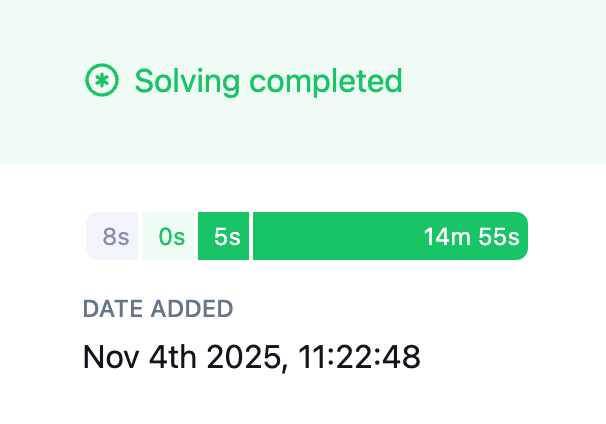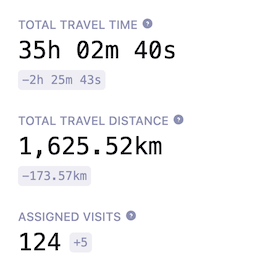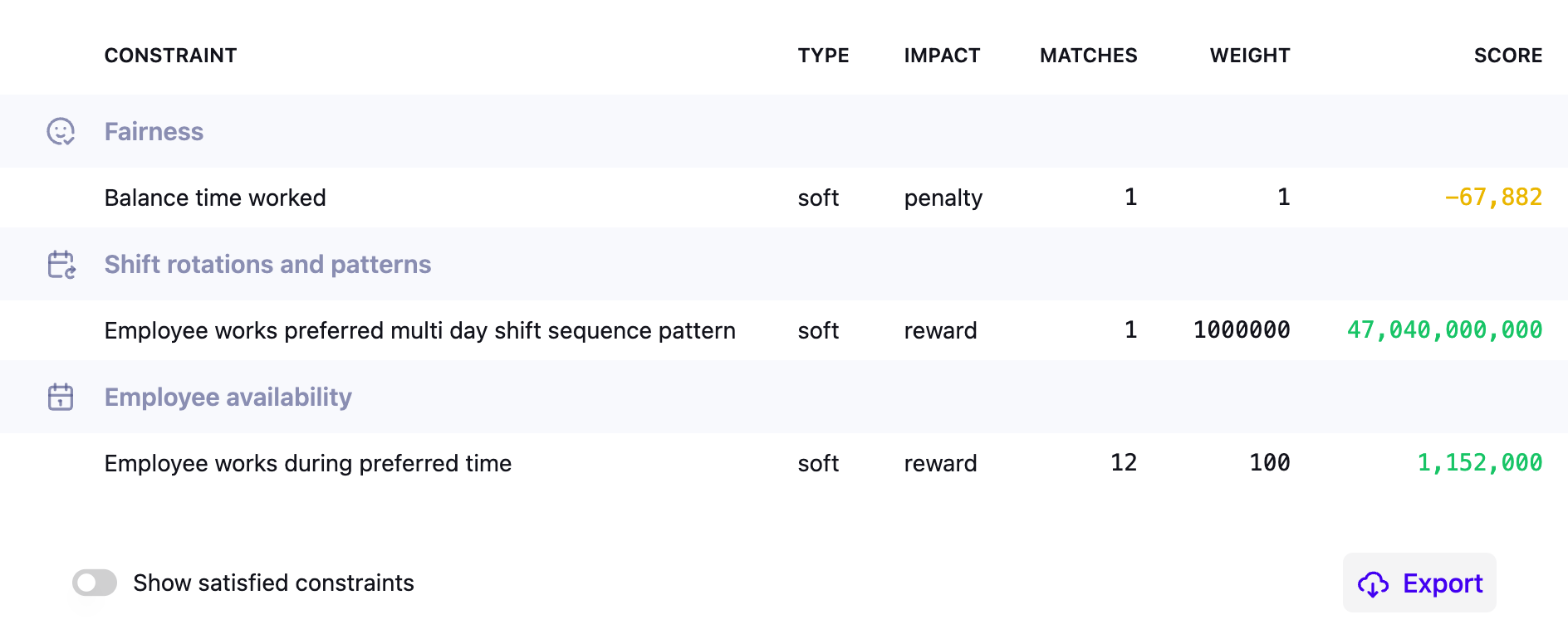Interpreting dataset results
In this document you will learn how to see the results of a dataset using the Platform’s UI, interpret its metrics, analyze the scores, and possible next steps on how to use and tweak the proposed planning solution.
Dataset detail page
When a dataset has completed, the Dataset detail page gives you a summary of the results from the dataset. Find this page by clicking the tile of a model, and then picking a dataset from the Plans overview table.
The detail page has the following sections:
-
Sidebar on the right, with (in this order):
-
The dataset’s status.
-
The dataset’s metrics.
-
The dataset’s properties.
-
-
Main section, with (in this order):
-
Optionally, any error or warning messages.
-
The input metrics
-
The score graph and the hard, medium and soft scores.
-
The list of constraints with their score analysis.
-
Sidebar
Dataset status and errors/warnings
A dataset’s status is indicated at the top right in the sidebar.
Learn more about the different statuses here: Dataset lifecycle.
If there were any errors or warnings related to the dataset (e.g. input validation) the overview page will show them.
Dataset timeline
The timeline widget shows the different stages the dataset has been in, and for how long. Hover over each of the stages to see when they started and how long they took.

Dataset metrics and optimization gain
Each model defines its own metrics. These are metrics that reflect the problem domain. Metrics give an indication of the quality of the provided solution.
The sidebar shows the values of all metrics for the final solution, along with the optimization gain for each metric.

Optimization gain is defined as the difference between the first and the last solution.
| When interpreting optimization gain, avoid focusing on a single metric in isolation. Instead, consider how different metrics relate to and influence one another. |
By default, we display the five most common metrics. You can view additional metrics by clicking More.
Metrics are ordered by most commonly relevant ones first.
Sometimes a metric will be displayed as --.
This means it’s not applicable for the current dataset, e.g. the metric "Visits within SLA" will be displayed as -- if no SLAs are defined for visits in the input data.
Dataset properties
Below the dataset’s metrics we show the other properties of the dataset:
-
Any tags added to the dataset. You can easily add more tags or edit existing ones. Use tags to make datasets easier to find and compare. Learn more here: Searching and categorizing datasets for auditability.
-
The move speed. This is an indicator of how quickly Timefold is exploring different solutions and Timefold’s performance.
-
The Dataset ID.
-
The Parent ID and Origin ID, shown only if the dataset was created from another dataset. The Parent ID refers to the dataset from which this one was directly created. The Origin ID refers to the very first dataset in that chain.
Main section
Score graph and scores
The score of a dataset is an indication of its quality. The higher the score, the better the constraints are met, and the more optimal the provided solution is.
We distinguish between hard constraints, medium constraints, and soft constraints and compute scores for each.
- Hard constraints
-
Hard constraints are the basic rules of the domain and must never be broken. If they are broken, the solution isn’t even feasible.
- Medium constraints
-
Medium constraints usually incentivise Timefold to assign as many entities as possible. They are used by Timefold to allow for overconstrained planning.
- Soft constraints
-
The soft constraints of a model represent the optimization objectives. They can be broken, but the more they are satisfied, the more optimal a solution is.
Timefold optimizes for a higher hard constraint score first (to find a feasible solution), then a higher medium constraint score (to assign as much as possible), and then a higher soft constraint score (to optimize the solution). The scores are the sums of each of the constraint scores, grouped by type.
The graph below that shows the evolution of the scores for hard, medium, and soft constraints during the solving of a dataset.

When you hover over the score graph, you’ll see the values for each of the scores and the metrics of the solution at that time and the difference to the first solution.
To focus on a specific section of time in the score graph, you can zoom in by selecting the section you are interested in. To zoom back out to the entire score graph click Reset Zoom.
By exploring the evolution of scores and metrics, you’ll get a glimpse into the dynamic of the model; how it balances the different constraints and what the effect on the metrics are.
Input metrics
Below the score graph is an overview of metrics related to the input. They give an indication of the size of the planning problem you’ve submitted. These help put the metrics in context.
Score analysis
Below you’ll find a list of all constraints defined by the model, grouped by functionality and ordered by score.
By default, constraints that are fully met are hidden. Click Show satisfied constraints to display all of them.
Each constraint includes the following information:
-
Name: The label used for the constraint.
-
Type: Whether it’s hard, medium, or soft.
-
Impact: Whether it contributes a penalty or a reward.
-
Matches: The number of times this constraint was not fully satisfied.
-
Weight (effective): The weight actually used by the model when computing scores.
For soft constraints, this can be 0 if the model disables the constraint because it isn’t used or triggered in the current solution.
This may differ from the weight you configured. To see the configured weight, go to the Configuration page of the dataset.
See Balancing different optimization goals for guidance on adjusting configured weights. -
Score: The contribution of this constraint to the score of its type.
|
If you configured a non-zero weight (for example, |
Constraints are grouped logically to make it easier to identify related ones and understand how they influence the overall solution quality.

The image shows constraints that aren’t fully satisfied for a dataset of the employee scheduling model.
Planning solution output and visualization
A visual representation of this plan can be found on the Visualization page. The goal of this visualization is to spot-check the quality of the output.
The full details of the solution can be found under Output. You can download the output as a JSON file with the full details of the plan.
Using the API
The information from this overview page is also available by using the Model’s API.
-
The
/{id}endpoint returns the best solution, including its metrics. -
The
/{id}/metadataendpoint returns the status of a dataset and any validation errors or warnings. -
The
/{id}/score-analysisendpoint returns a list of the constraints, their scores, matches, and justifications.
For more information about the API endpoints, go to a model’s API Spec page.
What’s next? Tweaking the planning solution
Now that Timefold has provided you with an optimized plan for your planning problem, there are several ways you can further tailor the solution to your business needs.
Changing the optimization goal
When there is a feasible solution (meaning all hard constraints are met), Timefold further optimizes for soft constraints. By default each of these constraints are given the same importance, but you can change the optimization goals.
| Use Configuration parameters and profiles to change the optimization goals for your datasets. |
Compare to other datasets
The Plans overview page, shows a table with the latest datasets of a model. By default we show the scores of each of the datasets, as well as the first metrics. Use the search functionality to compare specific datasets.
| Click Manage columns to customize which columns are shown on the overview page. You can pick which of the model metrics to compare. |
Plan around fixed segments
Timefold models allow you to pin certain segments, so you can fully customize a plan. Maybe there is an exception where you want to make sure a certain shift is done by a specific employee, or a certain visit is done by a specific vehicle. If you provide Timefold with pinned segments, it will honour those while planning around them.
Solve for longer, or shorter …
When a dataset’s solve operation ends is determined either by a time limit, or when the score of a dataset no longer changes. The score graph of a dataset gives an indication whether it is worth solving for longer. Whether the extra time spent solving is worth it depends on your business needs.